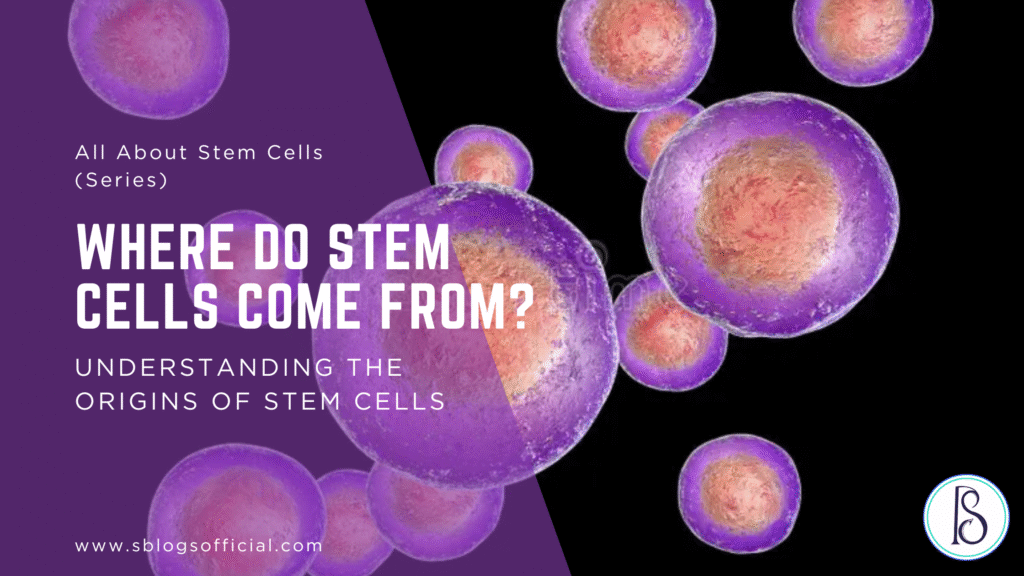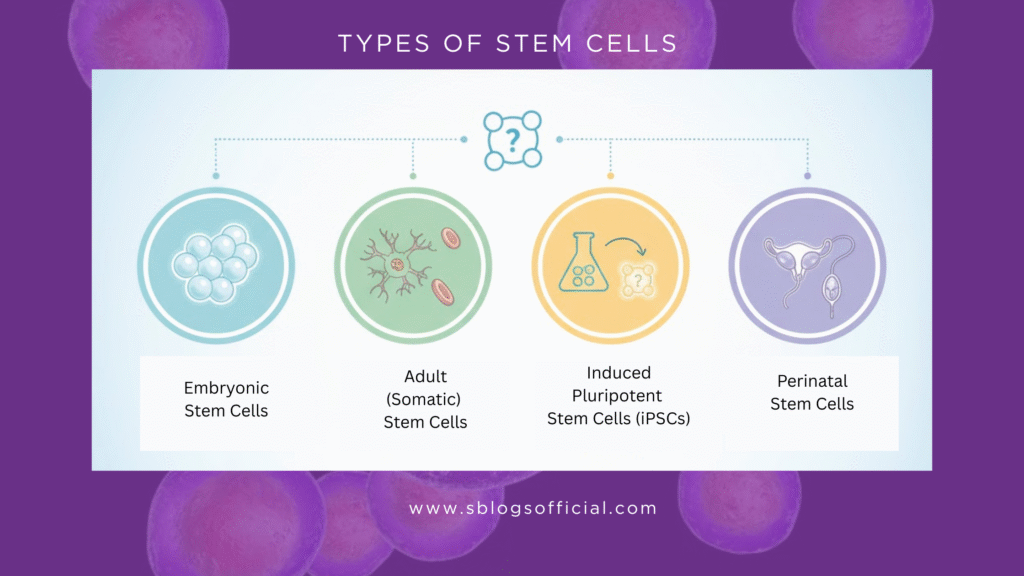
Stem cells are among the most fascinating and transformative discoveries in modern medicine. With their unique ability to develop into different types of cells, they hold the promise to repair damaged tissues, regenerate organs, and even treat diseases once considered incurable. From heart disease and diabetes to neurological disorders and blood cancers, stem cell research continues to redefine what’s possible in healthcare.
However, one of the most common questions that arises is — “Where do stem cells actually come from?” The answer isn’t as simple as many think. Stem cells can originate from multiple sources, each with its own strengths, limitations, and ethical considerations. Some come from embryos, while others are derived from adult tissues, fat, umbilical cord blood, or even created in the lab.
In this blog, we’ll break down the different sources of stem cells, clear up common misconceptions, and highlight why understanding their origins is crucial for both medical advancement and patient care. Let’s begin by answering some of the most frequently asked questions about stem cell sources and their uses.
What Are Stem Cells?
Stem cells are often described as the body’s “raw materials.”
They have two key abilities:
- Self-renewal – they can divide and produce more stem cells.
- Differentiation – they can transform into specialised cells such as muscle cells, blood cells, nerve cells, or skin cells.
These unique properties make them central to growth, development, and healing. But to fully understand their role, we must explore where stem cells come from.
Also Read- Cell Therapy (Stem Cell): The Future of Medicine Explained Simply
Main Types of Stem Cells and Their Sources
When people ask, “Where do stem cells come from?” the answer depends on the type of stem cell in question. Broadly, there are four categories:

- Embryonic Stem Cells
- Adult (Somatic) Stem Cells
- Induced Pluripotent Stem Cells (iPSCs)
- Perinatal Stem Cells
Let’s explore each one
Embryonic Stem Cells – Origins in Early Development
Embryonic stem cells are derived from embryos that are about 3–5 days old (at the blastocyst stage).
A blastocyst has around 150 cells, and the inner cell mass of this structure contains stem cells that can turn into virtually any cell in the human body.
These cells are considered pluripotent, meaning they can form all cell types except those needed to develop a fetus’s placenta.
So, if we ask where do stem cells come from in this category, the answer is: from embryos produced in laboratories during IVF (in vitro fertilisation), with consent from donors.
Applications:
- Disease modelling in laboratories.
- Understanding genetic disorders.
- Potential future therapies for spinal cord injuries, diabetes, and Parkinson’s disease.
Challenges:
Ethical concerns: their use involves embryos.
Immune rejection risks if not derived from the patient’s own genetic material.
Also Read- Can You Get More Than One Autoimmune Disease?
Adult Stem Cells – Origins in Mature Tissues
Unlike embryonic stem cells, adult stem cells exist naturally in our bodies throughout life. They are found in small numbers in various tissues and play a crucial role in repair and maintenance.
Sources of adult stem cells include:
- Bone marrow – home to hematopoietic stem cells (HSCs) that form blood and immune system cells.
- Fat (adipose tissue) – rich in mesenchymal stem cells (MSCs), which can differentiate into bone, cartilage, and connective tissue.
- Skin, liver, brain, and muscles – all have localised stem cells responsible for tissue repair.
Advantages:
Less ethical controversy than embryonic sources.
Already used in treatments such as bone marrow transplants for leukemia and lymphoma.
Limitations:
They are generally multipotent, meaning they can only turn into a limited range of cell types (e.g., bone marrow stem cells make blood cells, not nerve cells).
Their numbers and potency decrease with age.
So, when we ask where do stem cells come from in adults, the answer is: from various tissues of the body, especially bone marrow and fat.
Also Read- Supercharging T Cells: The Key to Stronger Immunity
Induced Pluripotent Stem Cells (iPSCs) – Lab-Made Origins
In 2006, scientists discovered how to take normal adult cells (like skin cells) and reprogram them back into a pluripotent state. These reprogrammed cells are called induced pluripotent stem cells (iPSCs).
How are they made?
By inserting specific genes into adult cells to “reset” them into an embryonic-like state.
Why are they important?
- iPSCs are pluripotent (like embryonic stem cells).
- They can be created from the patient’s own body, reducing the risk of immune rejection.
- They bypass ethical concerns of using embryos.
Limitations:
The reprogramming process is complex and not 100% efficient.
Safety concerns remain, as iPSCs may sometimes form tumours.
So, where do stem cells come from here? From ordinary adult cells (like skin or blood cells), reprogrammed in the laboratory.
Also Read- Hereditary Disease Screening | All about gene and health screening
Perinatal Stem Cells – Origins Before & Around Birth
Perinatal stem cells are found in tissues related to pregnancy and birth, such as:
- Umbilical cord blood
- Placenta
- Amniotic fluid
Collection process:
Cord blood is collected painlessly after birth.
Placental tissue and amniotic fluid can also be processed for stem cells.
Advantages:
Ethical issues are minimal since these tissues are usually discarded after delivery.
Rich in hematopoietic stem cells and mesenchymal stem cells.
This is why umbilical cord blood banking has become popular—parents can store stem cells from their newborn’s cord blood for potential future therapies.
Specific Sources:
Bone Marrow, Blood, and Cord To make it more practical, let’s detail common clinical sources:
- Bone Marrow: Spongy tissue in bones, especially the pelvis. Used in transplants for blood cancers.
- Peripheral Blood: Stem cells can be stimulated to move into the bloodstream and collected by a process called apheresis.
- Cord Blood: A rich and easily accessible source, collected after birth without risk to mother or child.
How Are Stem Cells Collected?
- Embryonic stem cells – obtained from IVF embryos in the lab, with donor consent.
- Bone marrow stem cells – extracted through a surgical procedure, usually from pelvic bones.
- Peripheral blood stem cells – donors are given medication to mobilise stem cells, which are then filtered out of the blood.
- Cord blood stem cells – collected from the umbilical cord and placenta after delivery.
- Fat tissue stem cells – collected through liposuction and processed in labs.
Why Does the Source of Stem Cells Matter?
- Medical application: The type of disease often determines which stem cell source is best. For example, blood cancers require bone marrow or cord blood stem cells.
- Ethics: Embryonic stem cells are controversial, while cord blood and adult stem cells are generally accepted.
- Immune system compatibility: Stem cells from the patient’s own body reduce rejection risk.
- Practicality: Some sources, like cord blood, are limited in volume, while bone marrow collection can be invasive.
Also Read- Genetic Methylation Testing | Body’s Cellular Programming
Current Medical Uses of Stem Cells
Stem cells are already used in several life-saving treatments:
- Bone marrow transplants for leukaemia, lymphoma, and multiple myeloma.
- Umbilical cord blood transplants for inherited blood disorders.
- Experimental regenerative medicine to repair heart tissue after a heart attack.
- Neurological research on diseases like Parkinson’s and Alzheimer’s.
Challenges Ahead
Even though stem cells are powerful, challenges remain:
- Risk of immune rejection in transplants.
- Difficulty in generating large numbers of stem cells for treatment.
- Ensuring safety, since some stem cells (especially iPSCs) may lead to uncontrolled growth.
- High costs and limited accessibility in many parts of the world.
Also Read- technological advances in organ transplantation
Stem Cell Therapy – Frequently Asked Questions
1. Do stem cells only come from embryos?
Ans. No. Stem cells can also come from adult tissues, umbilical cord blood, placenta, and amniotic fluid. In fact, scientists can even create stem cells in the lab, known as induced pluripotent stem cells (iPSCs).
2. Are stem cells from fat as useful as those from bone marrow?
Ans. Fat-derived stem cells, also called mesenchymal stem cells, show great promise for regenerative therapies such as cartilage repair. However, bone marrow stem cells are still the gold standard for treating blood-related diseases.
3. Can I use my own stem cells for treatment?
Ans. Yes, in certain therapies. Doctors can use your own bone marrow or fat-derived stem cells, which significantly lowers the risk of immune rejection and improves treatment safety.
4. Why is cord blood banking becoming so popular?
Ans. Cord blood is a painless and ethically accepted source of stem cells. It can be preserved for potential future use by the child or even their siblings, making it a valuable long-term health investment.
Also Read- mRNA Vaccines: Future of Medicine – Let’s explore!
Conclusion
The question “where do stem cells come from?” does not have a single answer. They can come from:
- Embryos in early development (pluripotent cells).
- Adult tissues like bone marrow, fat, and blood.
- Umbilical cord blood and placenta (perinatal tissues).
- Laboratory-engineered adult cells (iPSCs).
Each source has unique advantages and limitations. By understanding where stem cells come from, we not only appreciate their biological importance but also gain insight into how they can shape the future of medicine—offering hope for treating cancer, repairing damaged organs, and possibly curing chronic diseases.
References
- Nakamura, Y., & Collins, M. (2023). Stem cells: a comprehensive review of origins and emerging clinical applications. PMC. https://pmc.ncbi.nlm.nih.gov/articles/PMC9404248/ PMC
- Zheng, Y., et al. (2018). Sources and clinical applications of mesenchymal stem cells (MSCs). PMC. https://pmc.ncbi.nlm.nih.gov/articles/PMC6307657/ PMC
- Li, F., et al. (2022). Stem cell-based therapy for human diseases. Signal Transduction and Targeted Therapy, Nature. https://www.nature.com/articles/s41392-022-01134-4 Nature
- Mayo Clinic. Stem cells — What they are and what they do. https://www.mayoclinic.org/tests-procedures/bone-marrow-transplant/in-depth/stem-cells/art-20048117 Mayo Clinic
- Prentice, D. A. (2019). Adult stem cells. Circulation Research. https://www.ahajournals.org/doi/10.1161/CIRCRESAHA.118.313664 AHA Journals
- Li, J. (2022). Editorial: Adult stem cells for regenerative medicine. Frontiers in Cell and Developmental Biology. https://www.frontiersin.org/journals/cell-and-developmental-biology/articles/10.3389/fcell.2022.1069665/full Frontiers
- Salemi, S., et al. (2022). Adult stem cell sources for skeletal and smooth muscle tissue engineering. Stem Cell Research & Therapy. https://stemcellres.biomedcentral.com/articles/10.1186/s13287-022-02835-x BioMed Central
- “Types of Stem Cells in Regenerative Medicine: A Review.” (n.d.). Brieflands. https://brieflands.com/articles/jssc-14658 Brieflands
